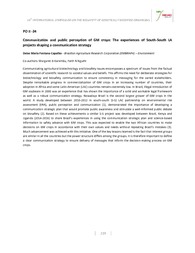Communication and public perception of GM crops: the experiences of South-South LA projects shaping a communication strategy.
Communication and public perception of GM crops: the experiences of South-South LA projects shaping a communication strategy.
Autoria: CAPALBO, D. M. F.; KAREMBU, M. G.; NGUTHI, F. N.
Resumo: Communicating agricultural biotechnology and biosafety issues encompasses a spectrum of issues from the factual dissemination of scientific research to societal values and beliefs. This affirms the need for deliberate strategies for biotechnology and biosafety communication to ensure consistency in messaging for the varied stakeholders. Despite remarkable progress in commercialization of GM crops in an increasing number of countries, their adoption in Africa and some Latin-American (LAC) countries remains extremely low. In Brazil, illegal introduction of GM soybeans in 2000 was an experience that has shown the importance of a solid and workable legal framework as well as a robust communication strategy. Nowadays Brazil is the second largest grower of GM crops in the world. A study developed between 2010-2012 in south-south (S-S) LAC partnership on environmental risk assessment (ERA), public perception and communication (1), demonstrated the importance of developing a communication strategic plan that would promote public awareness and stimulate a well-informed public debate on biosafety (2). Based on these achievements a similar S-S project was developed between Brazil, Kenya and Uganda (2014-2016) to share Brazil?s experiences in using the communication strategic plan and science-based information to safely advance with GM crops. This was expected to enable the two African countries to make decisions on GM crops in accordance with their own values and needs without repeating Brazil?s mistakes (3). Much advancement was achieved with this initiative. One of the key lessons learned is the fact that interest groups are similar in all the countries but the power structure differs among the groups. It is therefore important to define a clear communication strategy to ensure delivery of messages that inform the decision-making process on GM crops.
Ano de publicação: 2017
Tipo de publicação: Resumo em anais e proceedings
Unidade: Embrapa Meio Ambiente
Palavras-chave: OGM
Observações
1 - Por padrão são exibidas publicações dos últimos 20 anos. Para encontrar publicações mais antigas, configure o filtro ano de publicação, colocando o ano a partir do qual você deseja encontrar publicações. O filtro está na coluna da esquerda na busca acima.
2 - Para ler algumas publicações da Embrapa (apenas as que estão em formato ePub), é necessário ter, no celular ou computador, um desses softwares gratuitos. Sistemas Android: Google Play Livros; IOS: iBooks; Windows e Linux: software Calibre.
Acesse outras publicações
Acesse a Base de Dados da Pesquisa Agropecuária (BDPA) para consultar o acervo completo das bibliotecas da Embrapa.

